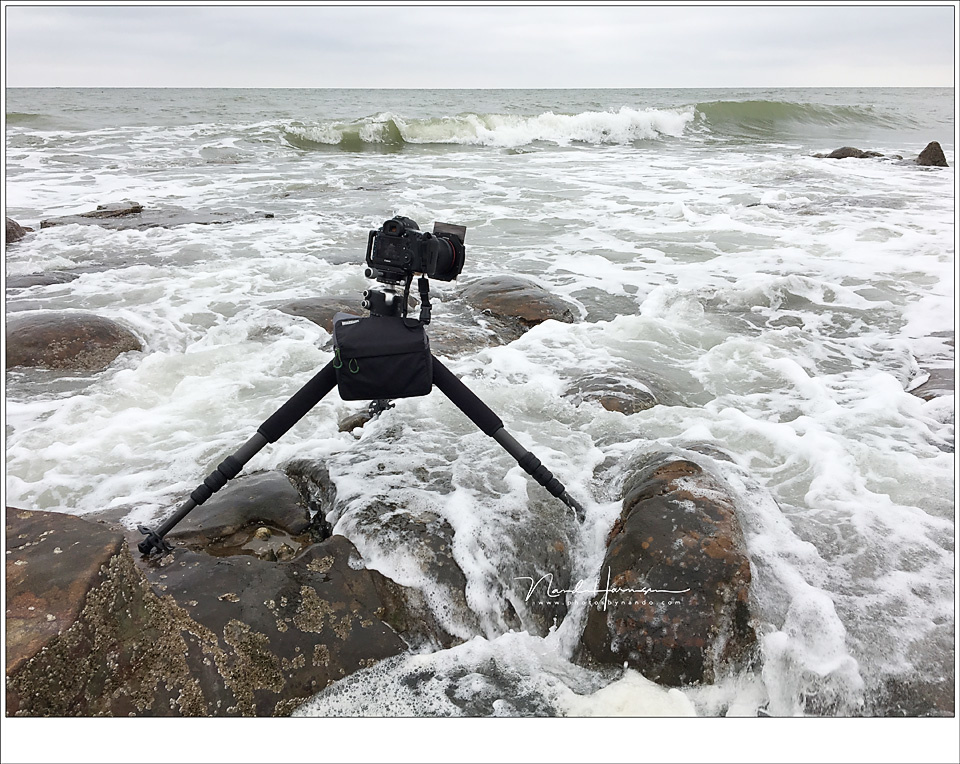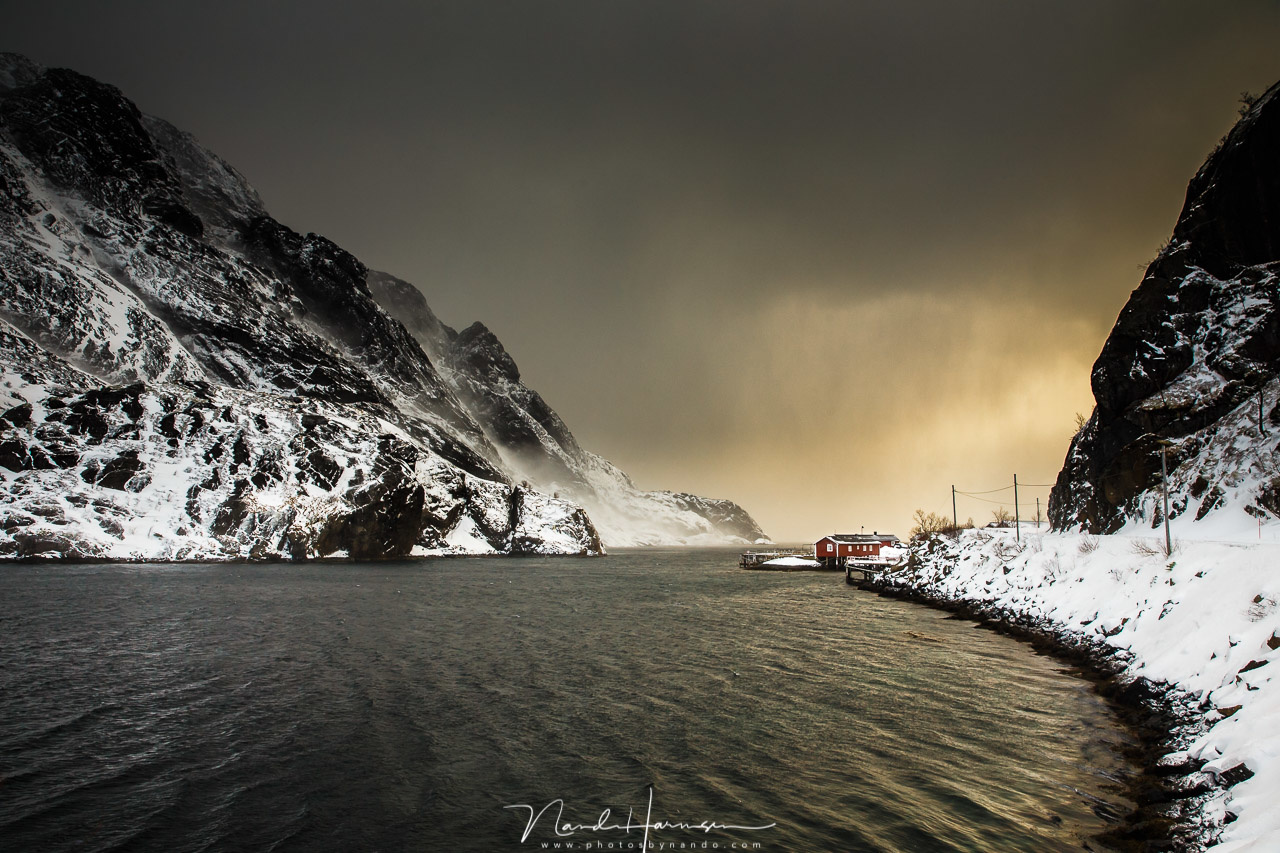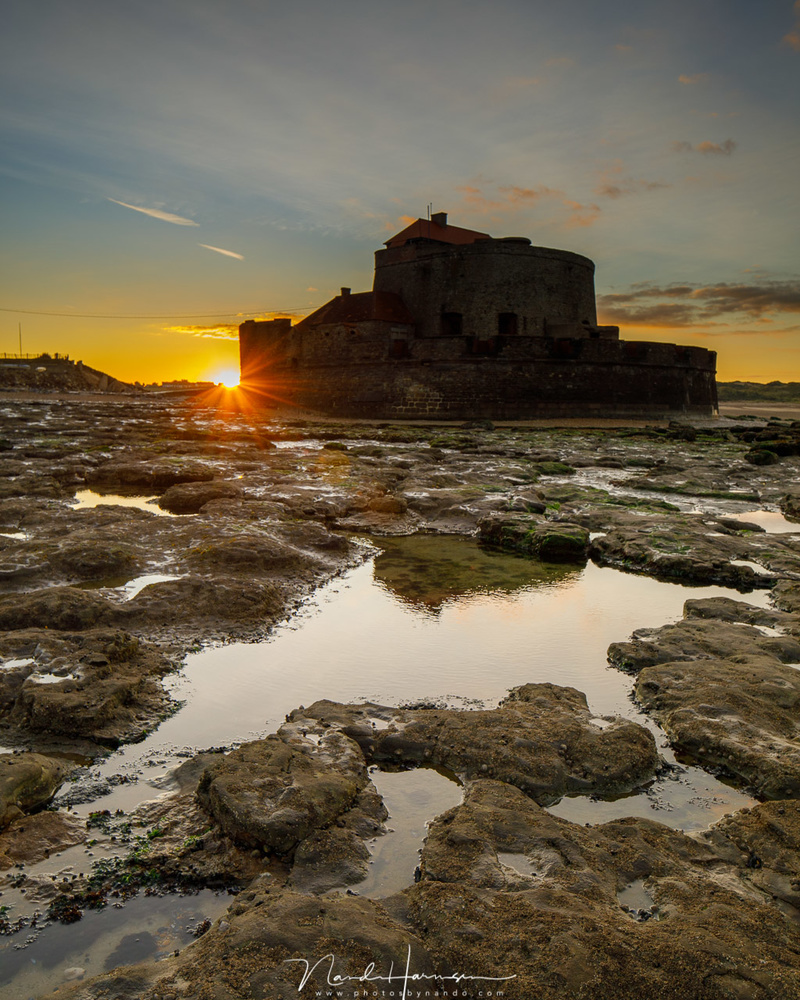The use of filters is very popular among landscape photographers. There are a lot of beautiful filters available that can help capture the landscape in the way you want to. But how useful are these filters in reality? Let’s have a look.
One of the difficult things in landscape photography is capturing the scenery the way you experience it. Often the dynamic range is larger than what the camera sensor can register, especially when we shoot sunsets and landscapes with part sky, part foreground. Although the dynamic range of modern cameras has increased, often you will have the risk of clipping highlights or shadows.

The dynamic range of this landscape is more than the sensor can manage. A neutral density gradient filter could balance the overal brightness of the image.
There are ways to avoid these problems, like shooting exposure bracketing. And it is possible to use neutral density gradient filters to reduce brightness in parts of the image. These filters allow you to reduce two, three, or four stops of light. By stacking filters it is even possible to increase this significantly.
There are roughly three types of neutral density gradient filters; the soft gradient, hard gradient, and the reverse gradient. These filters should allow you to reduce the dynamic range of the scenery in such a way, that it will fit within the limits of the camera sensor.
But this all is theory. When using filters in reality, some problems may occur. I have gathered seven reasons or situations, where these neutral density gradient filters may not be the only, or perfect solution.
1. You Have to Carry Extra Things
I want to start with something that I don’t find a big of a deal, but it might become a problem on some occasions. Most neutral density gradient filters are big and often vulnerable. Sizes like 100x150mm are standard, but there are also bigger ones. A smaller size is also possible, often for the micro 4/3 system cameras, or similar small size cameras. But even then, the relative size is enough to take a lot of space in your camera bag.

It is not a camera bag that is hanging on this tripod, but a bag just for the filters I have in use. It is the Mindshift Filterhive.
I use a very handy Mindshift Filter Hive, that packs in about the volume as a 70-200mm f/2,8 lens. If you love to take a lot of lenses with you, or you prefer to have a small camera bag, it might become difficult to find any place for all those filters.
2. Risks of Color Cast and Reduced Sharpness
Most lenses are designed to produce razor sharp images with a minimum amount of color cast. We pay a lot of money for those lenses, and don’t accept any less. By placing a filter in front of that expensive lens, it may reduce the quality of the image.
In most situations you won’t notice any difference in sharpness. But when using high resolution cameras, it may become noticeable. The amount of degradation also depends on the quality of the filter and the material it is made of, of course.

A selection of 3 stop GND filters from different brands. Some of these are really color neutral, others show a slight color cast. Some of these produce flares very quickly, others are very resistant to flares. From left to right: NiSi, Benro, Kase, Haida, Cokin
Color cast is another big issue, especially when the neutral density part is really dark. Although color cast can be corrected in post-processing, it will occur not equally over the image when using neutral density gradient filters. After all, it has a gradient. Also the amount of color cast depends on the quality of the filter, and the material the filter is made of.
3. Increased Risk of Reflections and Flares
Just like a degradation in quality, the filter may increase a risk of reflections or flares. Most modern lenses have a certain resistance to flares. By adding another piece of glass in front of the lens, it may counteract that resistance. Having direct sunlight in the image, some filters may even increase the amount of flares in such a way, the image will become unusable.
In the worst case situation the filter will become a mirror, reflecting the front of the lens. This is not always a big problem, but when there are notations on the front lens, these will become visible and sometimes even readable. A good quality filter may reduce the risk, though. Stacking filters will increase the risk.

The reflection that occured when using a filter. This one is extreme, showing the blurred letters that are printed on the lens barrel.
4. Filters Are Expensive
As I said, good quality filter may decrease the risks of color casts, reduced sharpness, and flares. But these filters are often very expensive. Buying a high quality starting set may cost you up to $1,000, or even more.
Spending such an amount of money is not always necessary. You have to take the resolution of your camera in mind, just as the quality of your lenses. It is no use buying very expensive filters when the lenses you use aren’t producing the best image quality. Also, very expensive filters are absolutely no guarantee for images without flares or other lens defects.
On the other hand, buying cheap filters of a lesser quality may become problematic when you upgrade your lenses, forcing you to buy another set that has better quality. Sometimes it is better to buy a good set the first time. Whatever you do, filters will always be expensive.
5. Struggling With an Uneven Horizon
Up to now I have mentioned filters in general, not the practical use in the field. The fifth downside is a more common problem regarding neutral density gradient filters; they always have a straight gradient.
When a straight horizon is present, a neutral density gradient filter can be used without problem. If something is obscuring the horizon, like trees, houses, or even mountains, a straight gradient may not be the best way to reduce the brightness of the sky. A filter won’t take the objects that break through the gradient into account. As a result the top of the mountains will also become darker.

A GND filter does not take mountains into account, resulting in not only a darkened sky, but also in dark mountain tops.
6. Imbalance in Brightness Between the Sky and Any Reflections in the Foreground
I find the biggest problem of neutral density gradient filters is the imbalance in brightness that can occur when something like water in the foreground is reflecting the sky. By darkening the sky with a neutral density gradient filter, the water will still reflect the light sky. This imbalance makes the image very artificial and it may require you to perform a lot of post-processing to correct this.

An example how a GND filter can darken the sky, bringing it well within the dynamic range of the sensor, but darkening the fort at the same time, and leaving the reflection of the darkened sky as bright as it would be without a filter.
7. I Can Use a Gradient Filter in My Post-Processing Software With More Flexibility
The modern post-processing software often allows you to add a digital gradient filter to any image. It will imitate the use of a real filter, without all the problems as I mentioned previously. You might even use a mask, to mask out any objects that break through a straight horizon, or to reduce brightness of parts in the foreground that reflect the sky.
The digital way of adding a neutral density gradient is more precise.

It is very simple to add a gradient onto an image in a post-production programm like Lightroom. The end result is similar to the use of a real filter on location. But this digital filter can easily be adjusted in any way, like making it an uneven gradient.
Why I Still Use Filters Regardless of All These Downsides
When I shoot landscapes, I almost always use neutral density gradient filters when a part of the image is much brighter than the rest. This might sound strange, when reading all the downsides of real filters. But for me photography is about registering the landscape on location, and capturing it in a way that is as close as possible to how I experience it. I love photography, and playing with filters to accomplish this, rather than trying to acquire this when sitting in front of a computer.
Nevertheless, when using filters I often also use exposure bracketing. I find the reduced dynamic range when working with these filters a benefit. It makes it much easier merging images into the final result.
Final Word
Although there might be more effective ways of registering a landscape, I enjoy the process of getting that shot with filters. It give me lots of enjoyment and satisfaction. For me, that is what is photography is all about.
How do you think of using neutral density gradient filters? Do you use these filters, or do you think it is ridiculous spending such an amount of money on something that often can be done in post-processing? I love to hear your opinion about this in the comments below.








I often use Photomatix for blending images in high contrast situations. I believe that when done correctly it produces excellent results. Also I agree that using luminance masking (Capture One) can work better than filters. Good article.
Thank you, aslo for sharing your workflow, Steve
I think you should always do photography using whatever gear or techniques you like, no matter how fiddly, outmoded or unnecessary they might seem to someone else. Because if you're out there enjoying the process, you'll focus on it, and hang around longer, and greatly increase your chances of getting something good.
That is a large benefit form taking more time to get the shot. You also have more time to look at the landscape and you start seeing things.
I couldn't agree with you more that using filters is fun... Growing up, I enjoyed painting frequently with acrylics, and using filters in photography I liken to having quality paint brushes that are specific to the art you want to make. Having a "pallet" of filters to use only adds to the experience making the photo envisioned a reality.
Great to read you are enjoying this also.
Here’s an idea: take one photo without filters and then take one with filters. In fact take lots of photos with different setups. It’s called digital film. The photography police won’t arrest you for taking photos that you never use. Unless your in Arizona where you are only legally allowed to take one sunset picture per day (unless it’s a cliche pic of the sunburst between the arms of a saguaro).
Is it really so, only allowing to take a single sunset pic?
Since I learned the techniques of exposure blending and luminosity masks I stopped using GND filters almost totally. And I am happy to decrease weight as mentioned above.
For travelling light it is excellent.
The thing about “fixing it post,” is that one can only fix what one has captured. One has to, therefore, use multiple shots.
If one decides to just not blow out the sky, one is not capturing adequate detail in the shadow. If one creatures adequate shadow detail, one loses detail in the highlights. (“Restore Highlight Detail” is not magic; it is a compromise).
So two (or more) shots, on a tripod for registration, blended in post, or one shot with a filter, no post, (and tripod optional). There is a place and time for both techniques.
A third option, especially if the horizon is not straight, is long exposure with dodging. Tripod (and possibly ND filters) necessary. No uneven colour casts. No flare issues, and no filter bags (unless ND filters used).
I believe this also; there is a place and time for both techniques. And often I do use multiple exposures, even with filters. After all, why limiting yourself if you can do both
(but only if necessary)
I bracket and find I can blend the images more seamlessly in photoshop. I am usually shooting when the light is changing, messing with filters is type last thing I need. I would rather spend the time, looking for alternative viewpoints etc.
I understand the thing you say. You can alos be at the location in time, allowing you to scout and find the alternative viewpoints before the moment is there. Using filters is just taking the right one by looking at the light. It is quick and easy, without 'messing with filters'
If I need to find alternative viewpoints when the light is great, I feel I am too late at the scene, regardless if I use filters or not.
I don't own a ND gradient because I have yet to be in a situation that it would be useful but where #5 wouldn't be a big issue.
Indeed. when the location you like to photograph is making the use of a GND impossible, like you mention, you don't need one. :)
Thanks for your informative article, Nando. Which brands of quality filters do you recommend? Right now, I would prefer to use round filters with step up/down rings, to be able to use them on all my lenses.
I can recommend Kase Wolverine filters or the new Haida Red Diamond filters. I use both at this moment.
Unfortunately good quality filters are expensive.
Schrodinger's filter
This is funny.
And both are true, depending on the situation. That is perhaps the most fun part.
I believe you wrote that same story in another article about filters a while ago. Still, you have to carry the filters, the filter holder, and it won't fix the issues I wrote about in my article.
Nando
great article and your very correct I've shot thousands of seascapes with reverse neutral density filters which in shooting seascapes is a MUST HAVE filter. Sure you can bracket for sure and then blend the images with luminosity masks but lots of bracketing creates nightmares for large prints.
LIKE BELOW
1. lots of wind and clouds moving between shots
2. waves at sea and shoreline moving between shots
3. waves crashing on rocks
4. often 7-9 stop difference
5. even with the reverse neutral density filter you still usually need 3-5 exposures.
Anyone who thinks they can underexpose an image and bring up the shadows to make the files look the same as using a reverse neutral density filter and then take the file and make a print above 30" without spending hours PP is wrong. And forget about using PS, LR or C1 filters to produce the same image as a ND can.
Also anyone who doesn't understand the fact that ISO has nothing to due with exposure is sadly reading or watching too much marketing BS high ISO or sensor gain is unfortunately not going to replace the proper exposure period.
«…the fact that ISO has nothing to due with exposure….»
Thank you for saying this. I have been saying this for quite sometime and most people dismiss it without actually reading my usually detailed explanation. Simply put, we use photons to make an image. It is right there in the name Photo-graphy. No photons, no image, not enough photons, not enough image.
Raising the exposure index does not add photons. (Indeed, it makes one use fewer photons). If one wants more details in the shadows, one has to use more photons in the shadows, either by opening the aperture, using a longer exposure time, or adding more light.
(I also try to explain that “high ISO noise” is not caused by a high exposure index, but by a lack of photons, and the Poisson distribution. They do not seem to get that, either).
Thank you for your extensive thoughts. I gues you presume almost everyone that is using bracketing for landscapes is using HDR merge functions, or the merging with luminocity masks. I have tried that last one, and I personally find it horrible.
To avoid all the issues you mention, it is possible to simply use layers and masks to hide or show certain parts of the image. Perhaps I will write an article about it someday. With this technique you avoid movement between the images in a lot of occasions.
While it might seem "expensive" to buy a good set of filters, if you make the right choice in the first place it then becomes a one-off, once in a lifetime purchase. Available across all your lenses.
It's similar to tripods - so many people start "cheap" and then realise the need a better one - and end up years later with a cupboard full of tripods, mostly unused. Having spent vastly more than they ever would have, if they'd made the right choice in the first place.
And no, you can only do "so much" afterwards, to correct [during post processing] something that shouldn't have been wrong in the first place. If you'd used appropriate filters on the camera, when you shot the image. Because by the time you get back to the studio, you'd be stuck with washed out highlights or under-exposed shadows - and while digital post processing does provide some relief, it can't put back into the image something that was never there in the first place.
By the way - thanks for a very informative and well written article!
The first thing that came to mind, after reading your first paragraph, was a comparison with tripods. But you mentioned this in the second paragraph. I totaly agree with your comment.
Thanks for your thoughts on this one